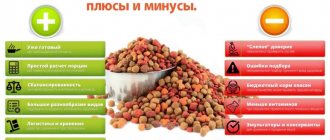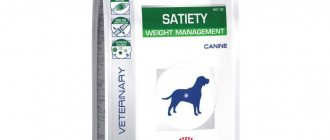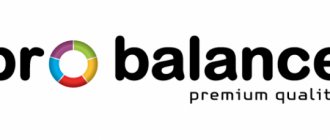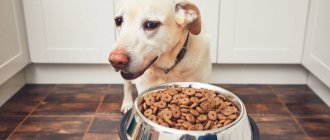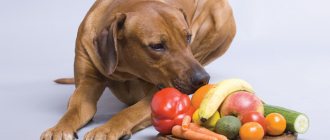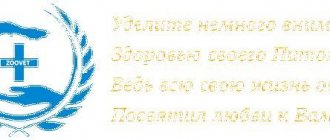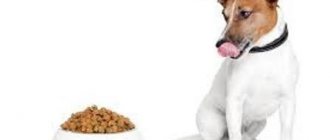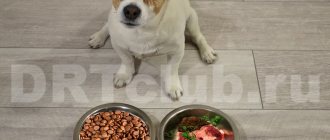Before getting a dog, you need to decide not only on the breed, but also on the upcoming costs of purchasing pet food. Correct calculation of a single serving is also important for the health of the animal, since overfeeding can lead to obesity, and excess weight, in turn, leads to other serious problems.
- 1 How to correctly calculate portions when feeding dogs
- 2 Frequency of feeding dogs
- 3 Diet by age and weight
- 4 Food standards for puppies
- 5 Food standards for adult dogs
- 6 Standards for natural nutrition
- 7 Feeding standards for wet food
- 8 Mr. Tail recommends: rules and regulations for feeding dry food (by breed, age, weight)
How to correctly calculate portions when feeding dogs
The amount of dog food depends on several factors:
- pet breed;
- weight characteristics;
- lifestyle;
- age of the animal.
It is quite natural that large-sized individuals (Alabai, bulldogs, German shepherds, Labradors) require twice as much food as indoor ones (Spitz, pugs, Chihuahuas, miniature pinschers, Yorkies).
An adult animal should be given up to 1 kg of dry food per day, while a puppy should be given 200 g.
If a dog is kept only outside, then its appetite is higher than that of a relative who is only taken out into the fresh air for a walk. Under mixed conditions of detention, you need to select your own nutritional standards. Active individuals burn energy twice as fast as lazy ones.
Over time, metabolism changes and digestion takes longer. Some processes fade away, causing irreversible metamorphoses in the body. Dry and roughage food should be replaced with liquid and semi-liquid food in order to be better absorbed.
Whatever type the animal belongs to, the rule remains the same - you should never overfeed it.
Feeding professionals believe that for an adult the daily intake should be no more than 1 kg of dry food.
You can divide portions into several meals, taking into account the class of food: economy, premium, holistic. The higher the brand of food developed by the manufacturer, the less it will be needed for one individual. It is also worth considering physical characteristics: large breed dogs eat much more than indoor dogs.
It is normal for your pet to feel hungry during the day. The main indicators that the food has been selected correctly are a healthy coat and body weight at which the dog can lead an active lifestyle.
Energy value of feed
To properly create a menu for your four-legged friend, you must first find out which food to give preference to. Dry mixtures are divided into four main categories, differing in calorie content, nutritional content and composition (percentage of meat, presence of trace elements and vitamins):
- economy class feed;
- premium;
- super premium;
- holistic.
When choosing the appropriate feed composition, do not forget that the higher the caloric content and nutritional value of the food, the less it is required by the animal. Thus, the most expensive foods are the most filling, so you need to give them to your pets in smaller quantities.
Economy class
Such food is produced from products of low quality; they have an energy value of about 250–300 kcal per 100 g. Food for economy-class dogs requires the mandatory introduction of additional vitamin and mineral supplements into the diet.
Premium class
This group of feed formulations contains various minerals and vitamins. Such industrial feeds, as a rule, contain a moderate amount of animal proteins (in the form of by-products and waste). The nutritional value of premium products is 300–350 kcal per 100 g.
- How to drink soda to lose weight - recipes for preparing the solution and contraindications
- Ultrasound of the intestine - what it shows and how it is done. How to prepare for an ultrasound examination of the large and small intestine
- Sea buckthorn - beneficial properties and contraindications for women and men. Benefits of sea buckthorn berries
Superpremium
Such foods are balanced and satisfying, from which the dog receives all the necessary substances. The mixtures contain high quality meat. The energy value of super premium dry food is 360–450 kcal per 100 g.
Holistic
For the production of such mixtures, the highest quality products approved for the food industry are used. Holistic category feeds have an energy value of 360-450 kcal per 100 g of product. They are suitable for feeding pregnant and sick pets that require the most careful handling.
Dog feeding frequency
How many times a day to feed a dog is entirely determined by its age. The frequency of feeding is selected depending on the individual characteristics of the animal.
Experts recommend feeding the animal more in the morning than in the evening. If for some reason one feeding is missed, then the second portion is not increased, since there is a danger of overeating.
You should also take into account the fact that many pets like to sleep after eating. Therefore, if the owner leaves the house for a long time, it makes sense to feed the dog before leaving so that during his absence he spends a significant part of the time sleeping.
Puppies are not weaned from their mother until 4 weeks of age and are kept breastfed. From the three-week period of life, they begin to accustom them to solid food and feed them up to 5 times a day every 4 hours.
When they reach two months of age, the number of feedings is reduced to 3-4, after six months of age - 2; One-year-old animals and older, depending on their physical condition, are fed once or twice a day.
Why do you need to calculate your daily intake?
Many owners refuse to feed their pets natural food and choose ready-made food, as this is one of the most convenient and affordable ways to provide the dog with all the necessary nutrients.
Complete food is convenient because manufacturers always indicate on the packaging how much food a dog needs per day. This is very important, since there is no one universal figure for all feeds at once; this figure fluctuates depending on the composition and calorie content of the feed. Why is it important to measure dog food and why shouldn’t you rely on their appetite when determining how much to give? Dogs very often try to eat all the food available to them, since in nature their ancestors did not get prey every day. A domestic dog does not need to get its own food, but the instinct remains, and “unlimited” access to food will very quickly lead it to obesity. Therefore, every owner must strictly monitor how much food his pet eats per day.
Let us immediately note that the daily dose is usually divided into two doses and given in the morning and evening after a walk, unless we are talking about puppies or dogs with a special feeding schedule. It is recommended to remove the bowl between meals. It is also very important to remember about the drinking regime: fresh water should always be freely available.
Diet by age and weight
If you take a small puppy into your home, then each feeding should be strictly on schedule, at least every 4 hours. If this rule is followed, the baby’s diet is established, which has a positive effect on the functioning of the digestive system.
Gradually, the periods between feedings increase; nighttime intake is best done after 6 hours. When the pet reaches six months or older, it is fed every 5 days during the day. A one-year-old dog is considered an adult and is fed 2 times a day.
To avoid digestive problems:
- the dog should rest one hour before meals and one hour after;
- You can’t play active games during rest, especially after eating;
- it is necessary to feed the animal in a calm environment;
- Keep the bowl clean, promptly removing all residues from it.
When underfeeding is dangerous
During pregnancy and lactation, animals' needs for energy and nutrients increase significantly. If your pet is expecting offspring, add 25–50% to her regular diet. And when she whelps, food should not be limited at all. Leave it freely available and let the dog eat as much as he wants throughout the lactation period.
It is quite normal for a nursing bitch to eat 200% of her normal intake. Malnutrition during this energy-consuming period is fraught with a decrease in the quality of milk and loss of health for the four-legged mother. If a dog is feeding puppies, but is unable to eat large amounts of food and is clearly losing weight, it is reasonable to switch it to a higher calorie product, such as Orijen Puppy Dog, which contains 520 kcal per 120 g.
Food standards for puppies
In order to correctly calculate the daily food intake for a puppy, you need to know its weight and the calorie content of the food itself.
The feed rate is indicated per 1 kg of weight.
| Age | Number of calories (kcal) |
| up to 1 month | 220 |
| up to 3 months | 270 |
| up to 6 months | 150 |
| up to 12 months | 120 |
If it is possible to buy elite food for them, then the dosage is made at the rate of 60 g per 2 kg of weight, not taking into account the calorie content of the food.
For small puppies, food is soaked so that they do not damage their baby teeth.
Gradually, dry food begins to be mixed with canned food, and then they are transferred to adult food.
What to do if your pet eats more or less than normal
Often incorrect calculations lead to the fact that the pet receives less or more than the norm. If a dog is constantly begging for treats, this does not always mean that he is hungry. It is worth taking a close look at the dog’s behavior.
The pet does not have enough portions if:
- after he has eaten, he does not want to leave the bowl;
- his ribs, edges of the shoulder blades and pelvic bones are clearly visible;
- thin layer of fat;
- the hungry pit is quite noticeable.
Based on these signs, you can understand that the dog does not have enough nutrition and nutrients; it is recommended to increase the portion. However, this should be done gradually, without adding a lot of food at once. You may need to switch your pet to another product that is higher in calories, or add various supplements and wet food to the diet.
If the pet does not finish the entire portion, leaves it in the bowl, and the presence of fat on it becomes quite noticeable, then it is worth reducing the portion a little. After eating, the food bowl can remain in place for another 15 minutes. (if there is anything left in it). Then you should remove it and not give anything to the dog until the next feeding.
Excess food leads to obesity in dogs
Important! If the product remains permanently, then the dosage is reduced, but also gradually.
Dry food is an excellent solution for pets. However, it is important for dogs to choose the right product. It is better to give preference to premium and super-premium food because they contain more protein and nutrients. It is necessary to create a dog’s diet taking into account its weight, age and body characteristics. The living conditions of the pet are also taken into account. If such food does not inspire confidence, then you can simply provide your pet with good natural nutrition.
Food standards for adult dogs
The amount of food per 1 kg of body weight per day for an adult dog depends on the breed and weight:
| Breeds | Number of calories (kcal) |
| Dwarf or very small (up to 5 kg, height up to 30 cm) | 100-120 |
| Small (from 5 to 10 kg, up to 40 cm) | 55-95 |
| Medium (up to 20 kg, 40-56 cm) | 70-80 |
| Large (from 20 to 30 kg, 56-65 cm) | 60-70 |
| Giant (50+ kg, from 60 cm) | 55-65 |
It should be taken into account that the animal may have food allergies.
Dogs over 7 years old are considered senior dogs. Due to their age, they may experience problems with their digestive system. If the diseases are pronounced, it is recommended to transfer such individuals to a special diet.
If, due to its age, the animal is obese, then, as a result, the following may occur:
- joint inflammation;
- disruption of the cardiovascular system;
- hormonal imbalances and changes;
- occur: diabetes, heart failure and arthritis.
Methods for calculating the amount of feed
Methods for calculating the amount of food for an adult dog depend on several facts. Key indicators are the calorie content of the food and the activity of the pet. For the calculations in the table, super-premium food is used as a basis:
| Dog weight in kg | Gram of feed per day | |
| High degree of activity | Low degree of activity | |
| up to 5 | 80 | 30 |
| 5–10 | 120 | 80 |
| 10–20 | 180 | 120 |
| 20–30 | 280 | 180 |
| 30–40 | 400 | 280 |
| 40–50 | 480 | 340 |
| 50–60 | 560 | 400 |
| 60–65 | 640 | 460 |
All food packages, regardless of type, contain a table with recommendations for calculating the daily food intake. The table contains several calculation options that include the dog's weight and activity. Naturally, the above standards should be considered as recommendations, and not instructions for action.
The recommended daily feed intake must be adjusted based on the practical result.
Important! Immediately after eating dry food, the dog does not feel full for 10–15 minutes. When in contact with water, the granules actively absorb it, increase in volume and fill the stomach, which gives the dog a feeling of fullness.
If your dog looks hungry 15–20 minutes after eating the food, the portion you calculated is too small. If after a similar period of time the dog becomes inactive, tries to lie down, or suffers from excessive gas formation, the portion must be reduced.
Standards for natural nutrition
With natural nutrition, take 40 grams of dry food, the same amount of wet food and fiber per 1 kg of body weight. For pregnant women, service dogs and stud dogs, the amount of natural food can be increased.
With average physical activity, a dog weighing up to 40 kg requires per day in grams:
- meat – 600;
- cereals – 500;
- vegetables – 200-300.
During heavy physical activity, a relative in the same weight category needs (in grams):
- fresh meat – 1000;
- cereals – up to 700;
- vegetables – 300.
For increased physical activity, for a dog weighing more than 40 kg, the following should be used per day (in grams):
- meat – 500;
- cereals – 700;
- vegetables – 400.
It is also recommended to add 50 g of meat and fish bone meal to the diet, from fermented milk products - kefir and fermented baked milk, in a volume of 100-200 ml, cottage cheese - from 200 to 500 g.
Individual approach
When deciding how much dry food to give a puppy per day, take into account its individual characteristics and living conditions. During the winter season, animals that live or spend a lot of time outside spend more energy on warming up, so their daily dosage can be increased.
If your pet is not gaining weight well on a diet calculated according to all the rules, then after consulting with a veterinarian, the amount of food can be increased. And when the increase, on the contrary, is too large, you should stick to the lower limit of the norm. Otherwise, the puppy is at risk of obesity, problems with the spine and joints due to excessive stress on the fragile skeleton.
